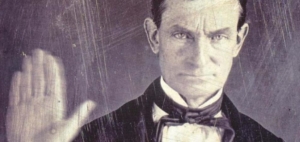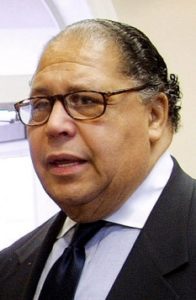The Bold Accomplishments of Women of Color Need to Be a Bigger Part of Suffrage History
An upcoming Smithsonian exhibition, “Votes For Women,” delves into the complexities and biases of the nature of persistence
Image: Anna Julia Haywood (Cooper), by H.M Platt, 1884 (Courtesy of Oberlin College Archives)
(Smithsonian) The history of women gaining the right to vote in the United States makes for riveting material notes Kim Sajet, the director of the Smithsonian’s National Portrait Gallery in the catalog for the museum’s upcoming exhibition, “Votes For Women: a Portrait of Persistence,” and curated by historian Kate Clarke Lemay. “It is not a feel-good story about hard-fought, victorious battles for female equality,” Sajet writes of the show, which delves into the “past with all its biases and complexities” and pays close attention to women of color working on all fronts in a movement that took place in churches and hospitals and in statehouses and on college campuses. With portraiture as its vehicle, the task to represent the story proved challenging in the search and gathering of the images—the Portrait Gallery collection itself is historically biased with just 18 percent of its images representing women.
In this conversation, Lemay and Martha S. Jones, Johns Hopkins University’s Society of Black Alumni presidential professor and author of All Bound Up Together, reflect on the diverse experiences of the “radical women” who built an enduring social movement.
Many Americans know the names Susan B. Anthony or Elizabeth Cady Stanton, but the fight for suffrage encompassed a much wider range of women than we might have studied in history class. What “hidden stories” about the movement does this exhibition uncover?
Lemay: Putting together this exhibition was revealing of how much American women have contributed to history but how little attention we have paid them. For example, when you think of African-American women activists, many people know about Rosa Parks or Ida B. Wells. But I didn’t know about Sarah Remond, a free African-American who in 1853 was forcibly ejected from her seat at the opera in Boston. She was an abolitionist and was used to fighting for citizenship rights. When she was ejected, she sued and was awarded $500. I hadn’t heard this story before, but I was really moved by her courage and her activism, which didn’t stop—it just kept growing.
The exhibition starts in 1832 with a section called “Radical Women,” which traces women’s early activism. You don’t think of women in these very buttoned-up, conservative dresses as “radical” but they were—they were completely breaking from convention. (more)
This Badass White Guy Hunted Slave Owners And Went To War With The System
(Disclose.tv) John Brown is a name almost unknown to most Americans today despite the fact that he was at the forefront of some of the most important moments of American history in the nineteenth century.
Brown was a passionate abolitionist hailed as one of the ‘greatest heroes known to American fame’ by the former slave and abolitionist Frederick Douglass.
In his lifetime, he also won praise from some of the most influential literary figures of the time including Victor Hugo, Ralph Waldo Emerson, and Henry David Thoreau. Perhaps Brown’s name has been largely lost to history because his indignation with the institution of slavery not only led him into non-violent resistance but to active, violent terrorism which would result in numerous deaths and arguably led to the breaking out the American Civil War. (more)
Commentary: Can we continue beyond Black History Month?
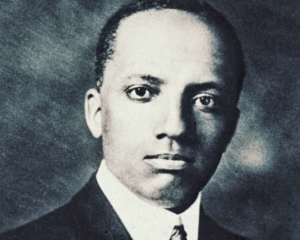
Dr. Carter Godwin Woodson, the first African American of direct enslaved parentage to earn a doctorate, was a driving force behind the celebration we now recognize as Black History Month. (Photo: Hulton Archive, Getty Images)
James L. Conyers, Jr., Ph.D., is Director of the African American Studies Program and Professor of African American Studies at the University of Houston.
(Houston Chronicle) Each February, the United States recognizes black history. The celebration started as just one day, though. In 1926, it became Negro History Week. Four decades later, it turned into the month-long tribute we observe today.
And it was initiated by Dr. Carter Godwin Woodson, one of the most important, but largely overlooked figures in American history.
Woodson was the first African American of direct enslaved parentage to earn a doctorate and the second to do so from Harvard University, in the discipline of history. Going far beyond the boundaries of traditional academic writing and researching primary and secondary sources, his scholarship addressed the influence of culture, prompting the development of African American studies programs and serving as the precursor to the civil rights, black power and black arts movements. He challenged conventional wisdom, studying disparity, inequality, hegemony and racial discrimination.
His approach to the study of African-American history is one we can apply to Houston’s history. In 1926, as Negro History Week was inaugurated, Houston was witnessing racial segregation that would soon become entrenched by redlining practices. Years earlier, in 1917, a race riot between Houston police and African-American military personnel stationed at Camp Logan inflamed tensions. (more)
TIPHC Bookshelf
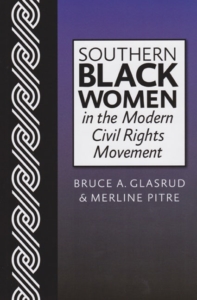 Published scholarship on black history in Texas is growing and we’d like to share with you some suggested readings, both current and past, from some of the preeminent history scholars in Texas and beyond. We invite you to take a look at our bookshelf page – including a featured selection – and check back as the list grows. A different selection will be featured each week. We welcome suggestions and reviews. This week, we offer, “Southern Black Women in the Modern Civil Rights Movement,” edited by Bruce A. Glasrud and Merline Pitre.
Published scholarship on black history in Texas is growing and we’d like to share with you some suggested readings, both current and past, from some of the preeminent history scholars in Texas and beyond. We invite you to take a look at our bookshelf page – including a featured selection – and check back as the list grows. A different selection will be featured each week. We welcome suggestions and reviews. This week, we offer, “Southern Black Women in the Modern Civil Rights Movement,” edited by Bruce A. Glasrud and Merline Pitre.
WINNER 2013 of the Liz Carpenter Award for Research in the History of Women, presented by the Texas State Historical Association
Throughout the South, black women were crucial to the Civil Rights Movement, serving as grassroots and organizational leaders. They protested, participated, sat in, mobilized, created, energized, led particular efforts, and served as bridge builders to the rest of the community. Ignored at the time by white politicians and the media alike, with few exceptions they worked behind the scenes to effect the changes all in the movement sought. Until relatively recently, historians, too, have largely ignored their efforts.
Although African American women mobilized all across Dixie, their particular strategies took different forms in different states, just as the opposition they faced from white segregationists took different shapes. Studies of what happened at the state and local levels are critical not only because of what black women accomplished, but also because their activism, leadership, and courage demonstrated the militancy needed for a mass movement.
In this volume, scholars address similarities and variations by providing case studies of the individual states during the 1950s and 1960s, laying the groundwork for more synthetic analyses of the circumstances, factors, and strategies used by black women in the former Confederate states to destroy the system of segregation in this country.
This Week in Texas Black History
Mar. 19
 On this date, in 1966, the Texas Western University (now Univ. of Texas at El Paso) basketball team upset heavily-favored Kentucky, coached by the legendary Adolph Rupp, to win the NCAA national championship. Texas Western coach Don Haskins started five black players against the all-white Wildcats. Rupp had vowed that his team would never lose to black players. It marked the first time an all-black five competed against an all-white five in the NCAA title game. David Lattin – who starred at Houston’s Worthing High School – was the starting center for the Miners. The team’s story was highlighted in the movie, “Glory Road.”
On this date, in 1966, the Texas Western University (now Univ. of Texas at El Paso) basketball team upset heavily-favored Kentucky, coached by the legendary Adolph Rupp, to win the NCAA national championship. Texas Western coach Don Haskins started five black players against the all-white Wildcats. Rupp had vowed that his team would never lose to black players. It marked the first time an all-black five competed against an all-white five in the NCAA title game. David Lattin – who starred at Houston’s Worthing High School – was the starting center for the Miners. The team’s story was highlighted in the movie, “Glory Road.”
Mar. 20
 Politician Willie Brown was born on this day in 1934 in Mineola. Brown became the first African American speaker of the California State Assembly in 1980 and served until 1995, the longest tenure for any of the Assembly’s speakers. From 1996-2004, Brown was mayor of San Francisco.
Politician Willie Brown was born on this day in 1934 in Mineola. Brown became the first African American speaker of the California State Assembly in 1980 and served until 1995, the longest tenure for any of the Assembly’s speakers. From 1996-2004, Brown was mayor of San Francisco.
Mar. 21
 Actor Al Freeman, Jr. was born on this day in 1934 in San Antonio. Freeman starred on Broadway in the 1960s in productions such as “Tiger, Tiger Burning Bright” and in plays by James Baldwin and LeRoi Jones such as “Blues for Mister Charlie.” In 1979, he became the first African American to receive a Daytime Emmy for a soap opera for his role as a police captain on “One Life to Live.” He also drew critical acclaim for his portrayal of Malcolm X in the mini-series “Roots: The Next Generations,” and in 1991 played Elijah Muhammad in the Spike Lee movie “Malcolm X.”
Actor Al Freeman, Jr. was born on this day in 1934 in San Antonio. Freeman starred on Broadway in the 1960s in productions such as “Tiger, Tiger Burning Bright” and in plays by James Baldwin and LeRoi Jones such as “Blues for Mister Charlie.” In 1979, he became the first African American to receive a Daytime Emmy for a soap opera for his role as a police captain on “One Life to Live.” He also drew critical acclaim for his portrayal of Malcolm X in the mini-series “Roots: The Next Generations,” and in 1991 played Elijah Muhammad in the Spike Lee movie “Malcolm X.”
Mar. 21
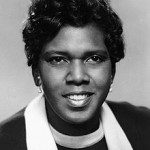 On this date in 1967, Barbara Jordan became the first black elected official to preside over the Texas State Senate. She was Texas’ first black state senator since 1883.
On this date in 1967, Barbara Jordan became the first black elected official to preside over the Texas State Senate. She was Texas’ first black state senator since 1883.
Mar. 22
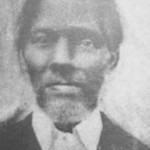 The first black state convention met in Austin on this day in 1866. The event, organized by the Texas State Central Committee of Colored Men, focused on the concerns – economic, political, civil rights – of black Texans. Rev. Jacob Fontaine (pictured) presided over the meeting. Several similar conventions were held in the following years, the last in Houston in 1895, and some delegates were sent to national conventions to express those concerns.
The first black state convention met in Austin on this day in 1866. The event, organized by the Texas State Central Committee of Colored Men, focused on the concerns – economic, political, civil rights – of black Texans. Rev. Jacob Fontaine (pictured) presided over the meeting. Several similar conventions were held in the following years, the last in Houston in 1895, and some delegates were sent to national conventions to express those concerns.
Mar. 22
Former Atlanta (Ga.) mayor Maynard Jackson was born on this date in 1938 in Dallas. Jackson was Atlanta’s first black mayor, serving from 1973-1981 and 1989-1993 and was the first African American to serve as chief executive of any major Southern city. Jackson and his family moved to Atlanta when he was seven years old. He earned a political science degree from Morehouse College in 1956, then a law degree from North Carolina Central in 1964.
Blog: Ron Goodwin, Ph.D., author, PVAMU history professor
Ron Goodwin is an assistant professor of history at Prairie View A&M University. Even though he was a military “brat,” he still considers San Antonio home. Like his father and brother, Ron joined the U.S. Air Force and while enlisted received his undergraduate degree from Texas Lutheran University in Seguin, Texas. After his honorable discharge, he completed graduate degrees from Texas Southern University. Goodwin’s book, Blacks in Houston, is a pictorial history of Houston’s black community. His most recent book, Remembering the Days of Sorrow, examines the institution of slavery in Texas from the perspective of the New Deal’s Slave Narratives.
Recent Posts
The Everlasting Light
Ye are the light of the world. A city that is set on an hill cannot be hid. Neither do men light a candle, and put it under a bushel, but on a candlestick; and it givith light unto all that are in the house. Let your light so shine before men, that they may see your good works, and glorify your Father which is in heaven. — Matthew 5: 14-16
This is the month set aside to honor…(more)
The Return of the Silent Majority
Fifty years ago, in January 1969, Richard Nixon was sworn in as the thirty-seventh president of the United States. His legacy as President was marred by the Watergate investigations and his eventual resignation from office which overshadowed the way in which he won the office. His central campaign rhetoric was designed to garner support from white Southerners (otherwise known in history as the “Silent Majority”) whose racial beliefs leaned heavily towards the support of white…(more)
Submissions wanted
Historians, scholars, students, lend us your…writings. Help us produce the most comprehensive documentation ever undertaken for the African American experience in Texas. We encourage you to contribute items about people, places, events, issues, politics/legislation, sports, entertainment, religion, etc., as general entries or essays. Our documentation is wide-ranging and diverse, and you may research and write about the subject of your interest or, to start, please consult our list of suggested biographical entries and see submission guidelines. However, all topics must be approved by TIPHC editors before beginning your research/writing.
We welcome your questions or comments. Please contact Michael Hurd, Director of TIPHC, at mdhurd@pvamu.edu.

